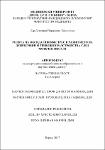I hereby declare that I will use the electronic library contents in compliance with COPYRIGHT AND RELATED RIGHTS ACT, Article 24, paragraph 1, item 9, only for scientific, cultural and educational purposes, without commercial gain, without commercial interest and non-profit.No Yes

The Role of Oxidative Stress in the Development of Depressive and Anxiety Disorders after Stroke // Ролята на оксидативния стрес в развитието на депресивни и тревожни разстройства след мозъчен инсулт

Date
2017Author
Комсийска, Детелина
Komsiiska, Detelina
oa@mu-varna.bg
Metadata
Show full item recordAbstract
Проучени са 93 пациенти, преболедували от мозъчен инсулт на възраст 39-87 г. На всички бяха изследвани основни клинични симптоми, а състоянието им беше оценявано със специализирани скали (HAM-D-17, MMSE, NIHSS, STAI, PHQ-9, PHQ-15, GAD-7). При всички пациенти бяха изследвани подбрани показатели на оксидативния стрес с помощта на спектрофотометрия и Електрон Парамагнитен Резонанс (ЕПР). Резултатите бяха обработени със съвременни статистически методи. Като резултати от изследването беше установено депресивно разстройство при приблизително 2/3 (64,5%) от пациентите с мозъчен инсулт, като от клиничните симптоми водещи са понижено настроение, безрадостност, повишена психична и соматична тревожност, безсъние, соматични оплаквания, с изводими от тях хипохондрични мисли. Генерализирано тревожно разстройство се установи при 70 (75.25%) пациенти. Установи се висока коморбидност между депресивните и генерализираните тревожни разстройства. Налице е повишен оксидативен стрес при болните с мозъчен инсулт и депресивни и тревожни разстройства, което проличава от повишени нива на ROS, NO, MDA, PC, 8-OHdG, CAT. От друга страна нивата на SOD и аскорбатни радикали се понижават. Поради тези резултати е уместно към комплексното лечение на депресия с антидепресанти да бъдат включени и антиоксиданти като витамин C, коензим Q, oмега 3 и др. The contingent of the study was 93 stroke patients, of which 59 men (39-83 years) and 34 women (56-87 years), with average age 66.8 years. The methodologies used are clinical, questionnaire, statistical and laboratory. The clinical methods include collecting complete information from patients, if possible and / or from close relatives, and available medical documentation on the underlying disease and concomitant illnesses, with emphasis on accompanying psychiatric history, deprivation of overall mental status, focusing on the affective sphere, somatic and neurological status and application of assessment scales (HAM-D-17, MMSE, NIHSS, STAI, PHQ-9, PHQ-15, GAD-7). Summarizing the results, it is found that the development of post-stroke depression is a common mood disorder affecting about a third of the patients with stroke. In our study, depressive disorder was reported in two-thirds of the patients with stroke. Generalized anxiety disorder in post-stroke patients was found in 70 (75.25%). There is a statistically significant positive correlation between depressive disorders and generalized anxiety disorders - increasing of severity of depressive disorder increases the severity of generalized anxiety disorder as well. In post-stroke patients with depression, there is increased generation of reactive oxygen species (ROS), increased levels of Nitrogen Oxide (NO), Malondialdehyde (MDA), protein-carbonyl (PC), 8-OHdG, and catalase enzyme (CAT) levels. The superoxide dismutase enzyme (SOD) decreases in the presence of depressive disorder after a stroke. Because of these results, antioxidants such as vitamin C, coenzyme Q, omega 3 and others are also appropriate for the complex treatment of depression with antidepressants.
